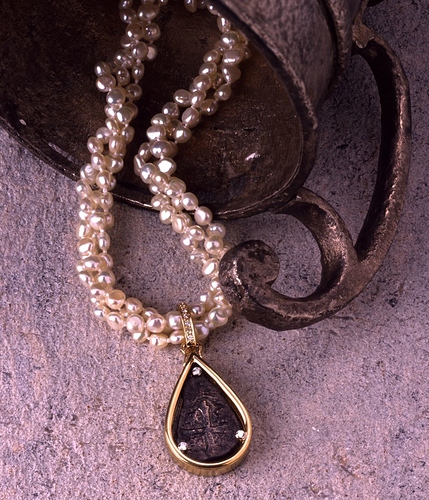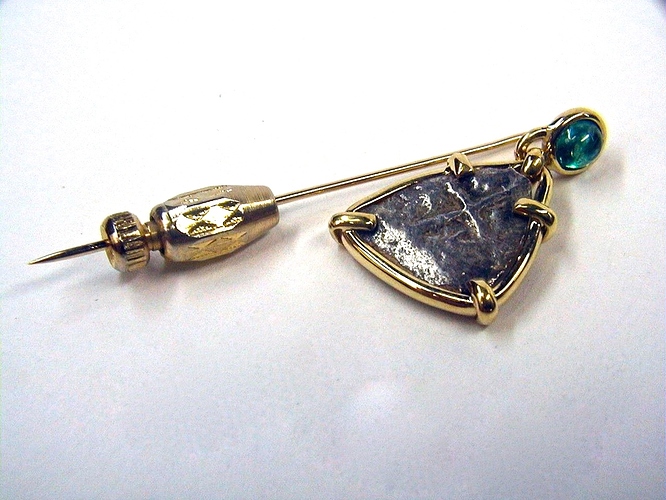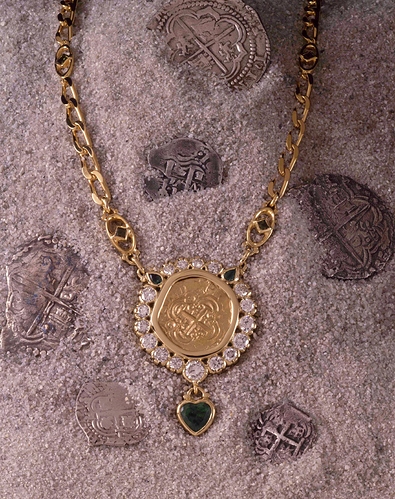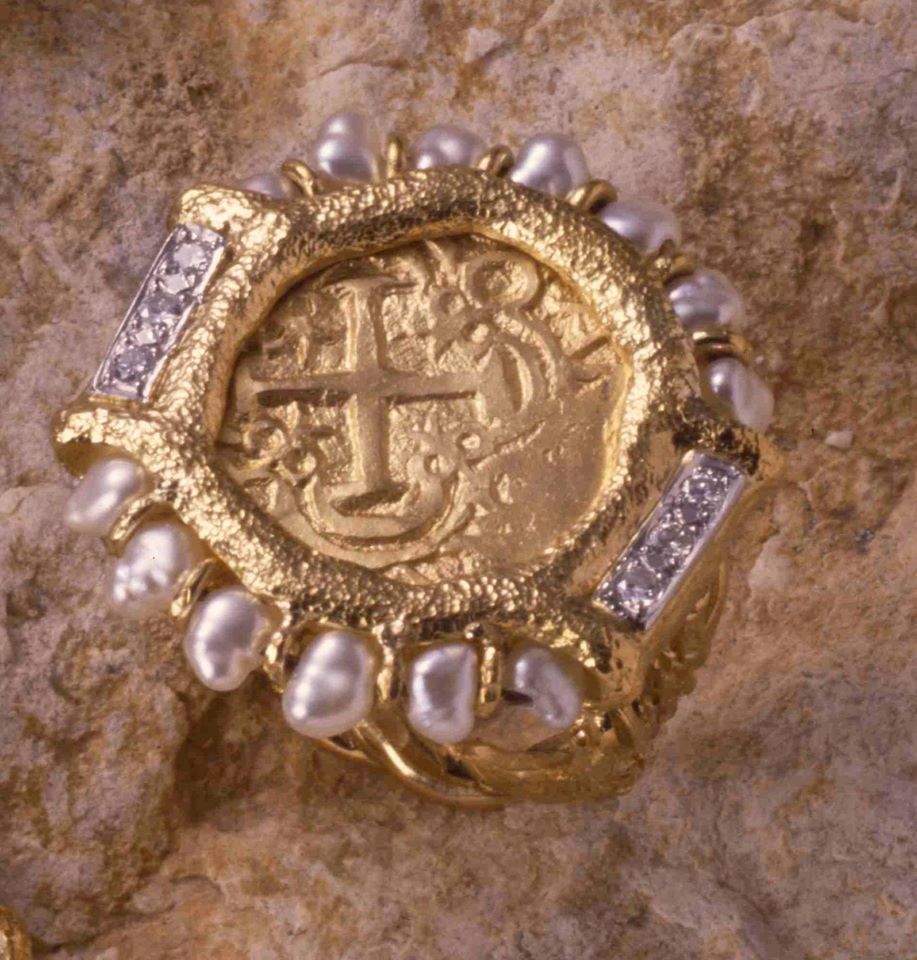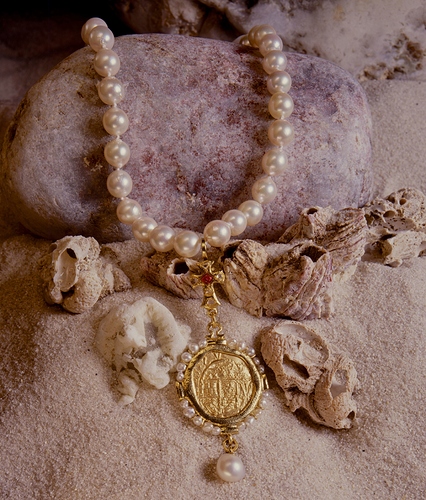i still cant get over how the 18ky. looks like it belongs there. your
artistry the period piece, all of it. belongs together. i do believe
had the people of the atocha or other shipwrecks been able to see
these, they would be thoroughly impressed. you are inspiring me to
create again. thank you.
Aaron
Thanks Aaron,
I appreciate the comment and enthusiasm,
We did a number of pieces in 22K too, more shots to come.
The only alternative to yellow in this time frame was silver, and though we do periodically do silver pieces, the contrast is not a dramatic. They were still 300+ years from managing platinum.
Thanks again,
Jim
Another of our Shipwreck pieces,
This coin is a “Frag” ( a fragmented coin, exposed to erosion from the 300+ years of shifting sand).
This coin is from the 1715 Fleet, known as the Plate Fleet.
The 11 ships, all sunk simultaneously off the immediate coast of Vero Beach, Florida, was one of the heaviest laden with treasure bound for Spain.
This group of boats sunk within sight of land, but again, the fear and lack of understanding of water had nearly all the crew and passengers drowning.
This is the wreck site that keeps giving.
Under the protectorship now of Kim Fisher, Divers can search the sight with a lease and approval, however, for over 300 years, every time a storm would pass through, new coins and artifacts would be uncovered.
You can still walk the beach today, and with a lucky kick, find a coin.
This piece, rendered in fabricated 18K k yellow gold, simply follows the form of the clearly visible Crusader’s Cross. All suspended on a grouping of Biwa pearls.
The backdrop is one of the silver vessels recovered from the Atocha.
You can clearly see the erosion on this piece,
The sea life was attracted to the oxides being given of by the copper/silver amalgam and formations would appear, and while protecting the artifact to some degree, the silver would still display deep pitting.
Enjoy,
Jim
Another simple one, Just a stick pin (old guys tie tack…)
Another one of "Those " emeralds.
This time a coin (1/2 Reales) from the 1715 Fleet, Nice cross, fabricated 18K yellow.
Enjoy,
Jim
youve got my enthusiasm going my friend, ive never priced one of these
coins, but curious what just an entry level coin would run. was
designing in my mind a rather plaiin pendant, OR a tie clip. first
things first, is the coin. ill end up stockpiling materials first.
anyways thank you yet again for the inspiration my friend.
Aaron
Hi Aaron,
Thank you.
I’m still working with the Fisher Family (now the grandkids…)
I’ll get some reference points for coin prices (and grades & how to ascertain values) as the new year starts.
There will be coins, artifacts & misc. pieces from the Atocha, Santa Margarita & 1715 fleet to start.
While they can get pricy, you’ll be surprised at how reasonable some can be.
Thanks again,
Jim
i had a quick glance just now, ( couldnt sleep lol) on ebay the pieces
of eight were reasonable. puts a potential project within my sights.
even had seen one set in what appears to be 14ky? which is why i had
fallen head over heels with your 18ky setting. specially with
diamonds. id have to ddo something original. whats your opinion on
rose gold?
Aaron
Please be careful of Ebay and associated “treasure” sales organizations.
For years now, people have been buying silver bars off the Atocha, melting them down… And using the re purposed material as faux coins, ( not stamped reproduction,( ileagle on EBay, and with US trade laws)
The chain of provenance falls away when copper alloys are added and the material is cast. People do it, but the story and most importantly, the integrity, falls apart.
Atocha coins will have " Treasure Salvors" signed, numbered Certs that can be traced back through the Mel Fisher museum, and are authorized by the State of Florida.
Santa Margurita Certs are held to the same standard.
1715 coins are a bit more difficult to trace, Sandy Dunns Certs, and the Fisher family Certs are solid, there are so many coins of this era around 1715 & later “Cobb” coins that their value is low, stories a bit suspect, but still interesting.
Please approach with caution,
Remember, I’m in the history and documentation end, with jewelry being the containment vehicle.
Best,
Jim
Love rose gold,
Lots of weird alloys that don’t fab well though.
I expand with some data soon,
Best,
Jim
Jim,
What a great message of caution. Thanks for the reminder.
Mary A
There are NO 14 k artifacts or coins. Period.
The standard of the Spanish rule ( and most others in history) is that gold coinage is 24 ct( .999 pure), there are a very few exceptions. Jewelry was generally 24 K too,
However, I’ve seen 20k pieces.
Silver, until coin silver came into use is , again, pure. Copper/ bronze is of an earlier era, with exception, and not generally associated with Spanish coinage, of the Carrabean,in the era is 1400’ s to early 1800’s.
Gold and silver artifacts are rare and expensive, now mostly seen at auction or traded by private collectors.
Simply beware of anything that doesn’t have a tracable document to support the " Treasurer" claim.
This is no different than early Egyptian or Greek artifacts, re-patriation applies unless there is verifiable proof of ownership.
Best,
Jim
Atocha…
again.
This is the piece that started my journey.
This is actually, though from the Atocha, a pre documented coin.
This was given to a friend in the late 1970’s as an incentive to invest in Mel’s operation. The gambit worked, and though the “Treasure salvors” certification had yet to be developed, this was found at the site and was one of the pieces the State of Florida tried to lay claim to. (unsuccessfully).
My friend did in fact invest, and an eight escudo gold coin like this is worth 10’s of thousands now.
The piece is a bit of history in it’s own right.
Surrounded with diamonds and a 2 carat heart shape emerald increase the value no doubt, but the styling was very 1978 to 1985 or so.
This was “The” look that people wanted.
Rendered in 18K yellow gold, a classic “Curb” link chain with our emerald set elements adding detail, this was the thing to have in that time.
Enjoy,
Jim
Amazing job, love the detail
Rustic…
The Atocha find was heralded in every newspaper in the country, National Geographic did a movie quality video (still available), books were written, the story keeps getting told…and , refined…
The era of the Atocha (1622) was anything but refined, Europe had shed the worst of the plague,the poor were poorer, the rich , richer. And though the Renaissance had started, at that time heretics were still being burned for thinking the world round…
So…
I like rustic, sort of like a brushstroke indicating a form. This ring is of that nature, rendered in 22k yellow gold, surrounded by natural pearls, a couple diamonds for accent, and, a beautiful 2 Escudo (Gold) atocha coin, clearly stamped and intended to look as a part of the whole , rather than stand alone.
Enjoy,
Jim
Atocha & rustic again…
After crafting the ring shown earlier, I fancied a pendant might be a welcome mate.
So here is another 22K yellow gold piece, set with a larger four Escudo gold coin, and again, surrounded by natural pearls. This is enhanced by an 8 mm fine cultured pearl strand and detailed with a ruby set cross of the era to tie the two together.
These escudos are not cleaned…or altered in any type of restoration process. 24 carat gold does not oxidize, even after nearly four centuries under water. So the coin you see is as pristine as the day it was minted (1618).
Enjoy,
Jim
(Sylvia Bissonnette photo)
Gorgeous, as usual. Could we see the clasp?
Noralie Katsu
Sorry Noralie…
Didn’t get a shot on it, it was a hook & eye style, 22K. I’ll post a similar one when I find a photo. It’s kinda a go-to staple for me.
Thanks, Jim
These are all wonderful! Thank you for posting them.
I particularly like (and will study some more) the way you design some with a nudge toward historical context, while others are showcased for the here and now (the eight reales piece (second picture, I think?) and the stick pin, for instance).
(Deleted a wordy treatise on the upheavals of the 17th century.)
Tricia
Hi Trish,
Thank you and
Please reinstate your treatise…
I have a background is history study of the Central American cultures and their interaction with the Spanish, primarily from Cortez through the early 1800’s.
My lectures, and the historical focus you see in either the writing or the pieces, has been on those interactions and the devastating effect of burning, melting or simply robbing the art of those indigenous cultures . Most of the early coinage (pretty much what you’ll see me post) was forged from metal that were Mayan /Peruvian art. Not a pretty picture.
My intent , from inception, was to create artful surroundings that allow a story to be woven that would bring shape and form to art lost, re purposed as a tool of war, and again brought back as a form of art (jewelry arts) that would respect the original cultures.
Thank, Jim
blockquote, div.yahoo_quoted { margin-left: 0 !important; border-left:1px #715FFA solid !important; padding-left:1ex !important; background-color:white !important; } I took my children downtown to see the Atocha exhibit. Security guards everywhere! Very few visitors. I was lost in the chain designs and the emeralds. Imagine my surprise when one of the attendants draped a chain on my very happy daughter! No camera with me back then though. It was neat to see pieces of eight and treasure.Cheers,Karen
